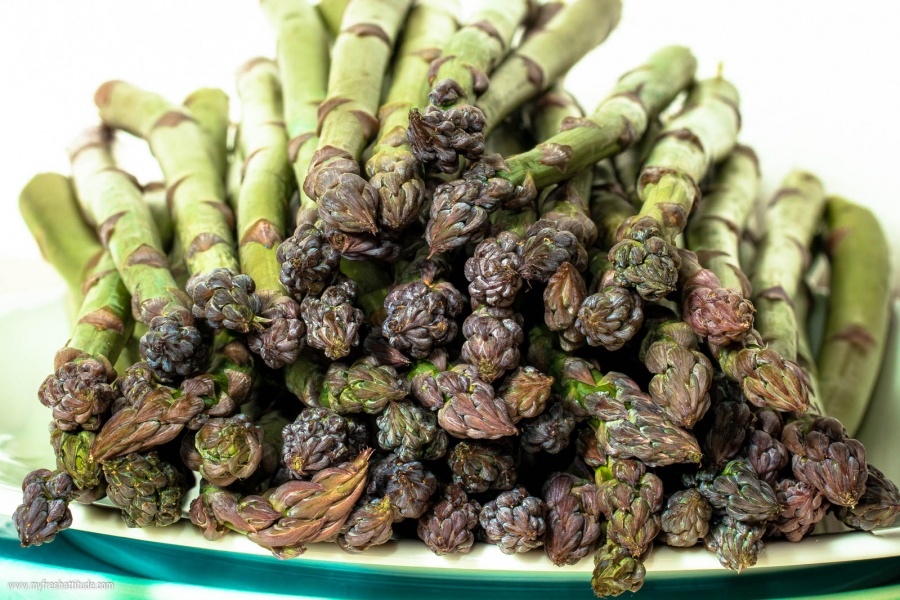
Asparagus
Asparagus have an interesting blend of Sulphur-like aromas, an intense sweetness (up to 4% sugar levels) and just the right hint of bitter notes to tickle the back of your tongue. At least that describes very fresh asparagus.
I personally have a love-hate relationship with asparagus (read Asparagus and Me for more details). On the one hand, I love the intensity of flavors from ultra-fresh asparagus and the sweet moisture that tends to dribble down the chin when I bite into a larger piece. On the other hand, asparagus is no longer a seasonal delight. It is available in most countries all year long, most traveling great distances to reach supermarket shelves many, many kilometers away from where it was harvested. It seems to me that asparagus is rapidly turning into a vegetable commodity like the onion or tomato.
Most vegetables have moisture and sugars when harvested. Asparagus have a lot…and most is lost within 24-48 hours of harvesting. The sugars begin to turn into starch molecules and shift the flavors into something bland and starchy instead of an incredibly tender, moist and sweet spring delicacy.
Asparagus is a member of the lily family. It is native to Eurasia and was enjoyed by the ancient Greeks and Romans.
There are many types of green asparagus on the market if you search or live near a field. Some types that are possible to find are pencil-thin, moderately thick, very thick, wild varieties (they look a lot like hop shoots) or some that are more purple in color than green.
White varieties also vary in size and thickness. White asparagus are purposely kept under a mound of dirt to prevent any exposure to sunshine – the lack of sun means no chlorophyll production and a white asparagus spear. White asparagus are not a different variety – just grown differently.
White asparagus has a more delicate aroma than green varieties, although the stem end tends to be bitter. Purple asparagus are colored with healthy anthocyanins, but they fade and turn green when cooked in water. Purple asparagus are also quite tender and are delicious shaved raw into a salad. The flavor intensity varies a lot with green asparagus. The thin, early season varieties are quite subtle when compared to the thicker, later-season green asparagus spears.
Season: Asparagus are best when bought during the spring months. The green and wild varieties are available first. White asparagus usually appear a few weeks after the green varieties.
European farmers live by a saying when it comes to asparagus season: ‘When the cherries are red, the asparagus are dead.’
Selecting and Storing: Fresh asparagus have the same characteristics. Look for tight tips first. A loosening of the tips implies age or late harvesting. This makes sense when you think about the plant – as it matures, it wants to open up and begin to blossom into a fern-like plant. The next characteristic to check is the skin of the asparagus. They should be smooth, with no signs of cracking, splitting or becoming excessively woody. Some say, if you rub two spears together, they should screech if they are moist and fresh. This is generally true, but it may be frowned upon in a supermarket. Finally, the cut end of the asparagus should not appear dry or cracked – the cut should seem new.
Once bought, fresh asparagus should be eaten as quickly as possible. The longer you hold them in your refrigerator, the more bitter they will become when you cook them. My preferred method of holding asparagus for a day or two is to rinse them briefly when I get them home, and then wrap them in a moist towel. I keep them on a plate or platter in the refrigerator for no more than 3 days. Some people like to stand asparagus spears in a glass or measuring cup with about 2-cm (one inch) of water. I tried this once and didn’t notice any significant benefit (plus I caught my sleeve in a spear when reaching for something else and spilled a bunch of water in the refrigerator and onto the floor – I stopped doing this after that mishap).
Preparing and Cooking: I think it is a good idea to remove a portion of the stem end from green and white asparagus. Some people claim you should just bend green asparagus until it breaks off, but I usually use a knife and cut off a portion of the stem end at the point where I think it is getting too woody…this point varies from spear to spear. I always remove about 3- 4-cm (about 2-inches) from the stem of white asparagus and trim that end aggressively with a peeler.
Green asparagus can be eaten raw, steamed, blanched in salted water, grilled or roasted. When boiling, always begin trying the spears after a couple minutes – just cut off a part near the stem end to check for doneness. I tend to cook green asparagus stems in boiling water without the head – I add the top part (the head) during the last 2 minutes of cooking. Roasting or grilling green asparagus takes about 20 minutes in a 200°C (400°F) oven.
White asparagus are traditionally poached whole in water for about 15-20 minutes. It helps a great deal to put some acid in the water to prevent oxidation – something like lemon juice or an acidic white wine helps keep that beautiful white color. Make sure the water is well-salted – something like the taste of the sea. And add a tablespoon of sugar to the water – a technique that helps put some of the sweetness back into the asparagus.
Nutritional Info: Asparagus are excellent sources of vitamin A, B, C and K. They also have healthy amounts of iron, fiber and potassium…and moderate amounts of calcium and magnesium.
Jack’s Fresh Tip

Moisture and sugar loss in asparagus can be partially remedied by soaking the asparagus in diluted sugar water before cooking – about 1 or 2 teaspoons per cup of water should be adequate.
White asparagus is always more fibrous than green asparagus (they also become harder while in storage), which is why they should be peeled from top to bottom…and even more from the stem end.
References
- On Food and Cooking, Harold McGee
- Six Seasons, Joshua McFadden
- Vegetables, James Peterson
- The World’s Healthiest Foods, George Mateljan
- Die Jahreszeiten-Küche – Gemüse, Susanna Krebs und Hildegard Loretan
- Mediterranean Grains & Greens, Paula Wolfert
- Das grosse Buch vom Gemüse, Teubner
Recipes with Asparagus
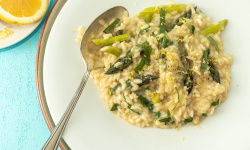
Lemon Risotto, Asparagus and Wild Garlic
3 2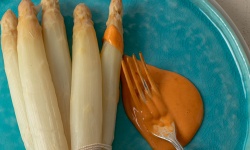
Poached White Asparagus
2 0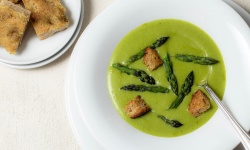
Asparagus and Pea Bisque
1 0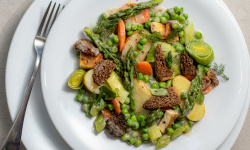
Spring Vegetable Fricassée
1 2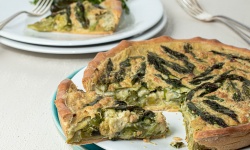
Asparagus and Leek Quiche
2 2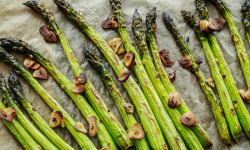
There are no comments